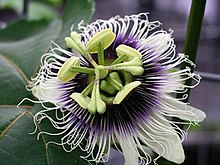Passion fruit
| Passiflora edulis | |
|---|---|
 |
|
| Flower | |
 |
|
| Fruit | |
| Scientific classification | |
| Kingdom: | Plantae |
| (unranked): | Angiosperms |
| (unranked): | Eudicots |
| (unranked): | Rosids |
| Order: | Malpighiales |
| Family: | Passifloraceae |
| Genus: | Passiflora |
| Species: | P. edulis |
| Binomial name | |
|
Passiflora edulis Sims, 1818 |
|
| Nutritional value per 100 g (3.5 oz) | |
|---|---|
| Energy | 406 kJ (97 kcal) |
|
22.4 g
|
|
| Sugars | 11.2 g |
| Dietary fiber | 10.4 g |
|
0.7 g
|
|
|
2.2 g
|
|
| Vitamins | |
| Vitamin A equiv. |
(8%)
64 μg
(7%)
743 μg |
| Riboflavin (B2) |
(11%)
0.13 mg |
| Niacin (B3) |
(10%)
1.5 mg |
| Vitamin B6 |
(8%)
0.1 mg |
| Folate (B9) |
(4%)
14 μg |
| Choline |
(2%)
7.6 mg |
| Vitamin C |
(36%)
30 mg |
| Vitamin K |
(1%)
0.7 μg |
| Minerals | |
| Calcium |
(1%)
12 mg |
| Iron |
(12%)
1.6 mg |
| Magnesium |
(8%)
29 mg |
| Phosphorus |
(10%)
68 mg |
| Potassium |
(7%)
348 mg |
| Sodium |
(2%)
28 mg |
| Zinc |
(1%)
0.1 mg |
| Other constituents | |
| Water | 72.9 g |
|
|
|
|
|
| Percentages are roughly approximated using US recommendations for adults. Source: USDA Nutrient Database |
|
Passiflora edulis is a vine species of passion flower that is native to southern Brazil through Paraguay to northern Argentina. Its common names include passion fruit or passionfruit (English), maracuya (Spanish), grenadille (French), maracujá (Portuguese) and lilikoʻi (Hawaiian).
It is cultivated commercially in tropical and subtropical areas for its sweet, seedy fruit. The passion fruit is a pepo, a type of berry, round to oval, either yellow or dark purple at maturity, with a soft to firm, juicy interior filled with numerous seeds. The fruit is both eaten and juiced; passion fruit juice is often added to other fruit juices to enhance aroma.
The passion fruit is so called because it is one of the many species of passion flower, leading to the English translation of the Latin genus name, Passiflora. Around 1700, the name was given by missionaries in Brazil as an educational aid while trying to convert the indigenous inhabitants to Christianity; its name was flor de las cinco lagas or "flower of the five wounds" to illustrate the crucifixion of Christ, with other plant components also named after an emblem in the Passion of Jesus.
Passion fruit is widely grown in tropical and semitropical regions of the world. Within the United States, it is grown in Florida and California. Certain cultivars are resilient against light frosts, and thus can survive perennially, even in more temperate climates such as that of Great Britain.
...
Wikipedia
